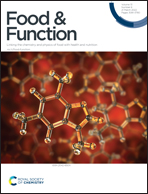Variations of the viscous properties of a sponge cake artificial bolus with some physiological parameters†
Abstract
Artificial boluses were prepared from sponge cake by grinding the food to a given particle size and hydrating with artificial saliva. The shear viscosity of the artificial food bolus was then measured by capillary rheometry, and its variations with shear rate were studied as a function of four main factors: bolus water content, particle size, temperature and saliva viscosity. The flow curves can be fitted according to the Herschel–Bulkley model, which allows for the derivation of two main properties: yield stress and consistency. Saliva plasticizing coefficients are defined by the variations of these properties as a function of the water content. Their value, close to 12, is in good agreement with values obtained for molten starch (10 < α < 20). Particle size has little influence, whereas the effect of temperature and saliva viscosity is not monotonous. They underline the complexity of the structure of the bolus and the interplay between the saliva, acting as a lubricant and a swelling agent. Finally, the extensional viscosity of the artificial bolus is also determined by capillary rheometry, and it is shown to be of importance when comparing the viscous properties of the artificial bolus with those of real ones from literature.

- This article is part of the themed collections: Food structure, sensory perception, and nutrition and Food & Function HOT Articles 2022


 Please wait while we load your content...
Please wait while we load your content...